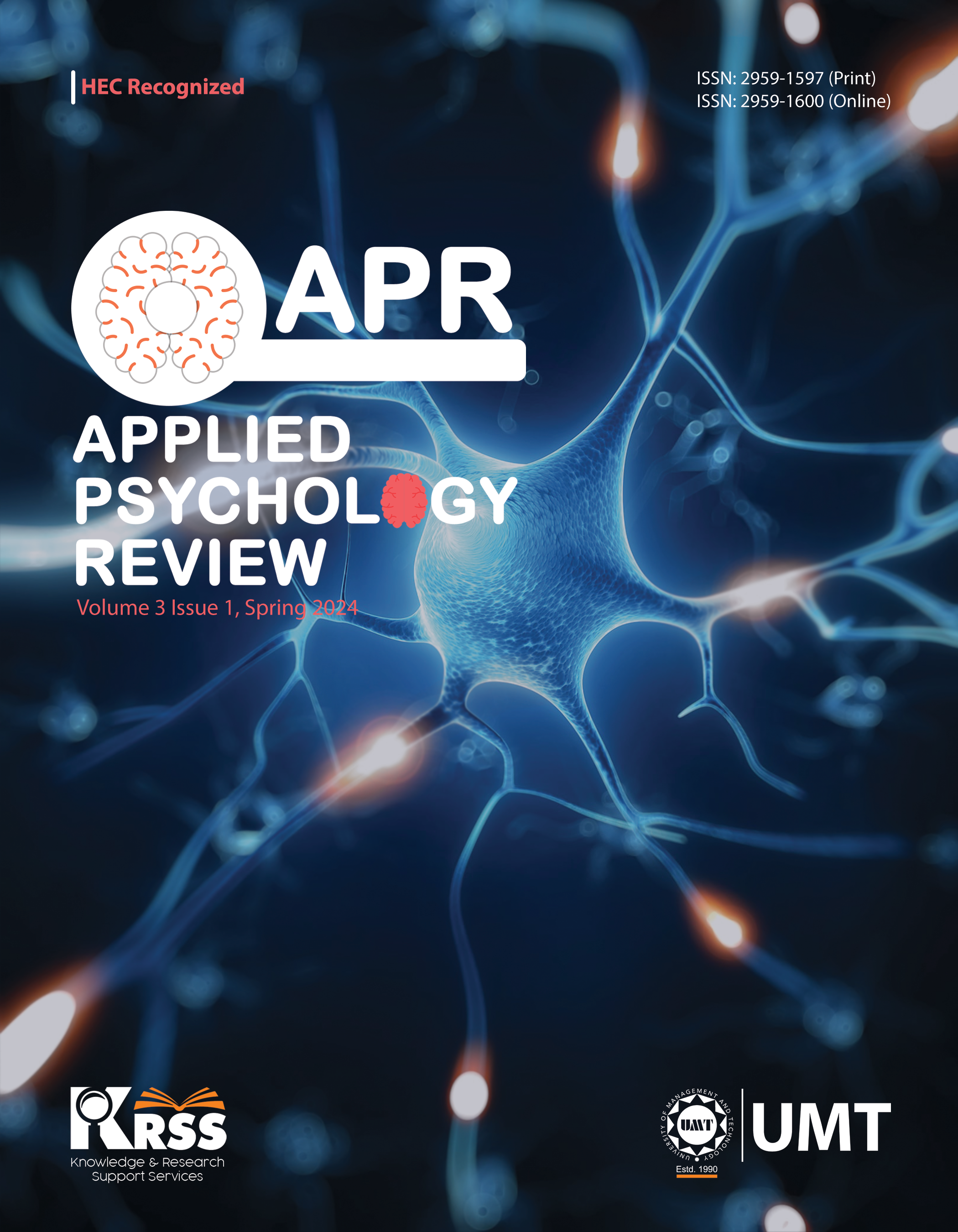Cyber-Stalking, Social Comparison, and Psychological Well-being in University Students
Abstract
 Abstract Views: 0
Abstract Views: 0
The current study aimed to investigate the relationship between cyber stalking, social comparison, and psychological well-being in university students. Correlational research design and quantitative method were used to conduct the study. It was hypothesized that there is likely a relationship between cyber stalking, social comparison, and psychological well-being. Moreover, it was also hypothesized that cyber stalking is likely to negatively predict psychological well-being in students. Data was collected online through purposive sampling technique. The study consisted of (n=150) university students. Standardized measures, Cyber Obsessional Pursuit Scale, Social Comparison Orientation Scale, and Psychological Well-being Scale, were used to collect the data. Data was analyzed using SPSS version 21. The results of correlational analysis showed highly significant correlation between all study variables. Regression analysis showed that only cyber stalking and social comparison were the significant predictors of psychological well-being in students. These results imply that authorities and respective institutions must devise psychosocial interventions to minimize the psychological disturbances in social media users by controlling cyber-crimes and to promote well-being at individual and societal level.
Downloads
References
Al-Rahmi, W. M., Yahaya, N., Alamri, M. M., Aljarboa, N. A., Kamin, Y. B., & Saud, M. S. B. (2019). How cyber stalking and cyber bullying affect students’ open learning. IEEE Access, 7, 20199–20210. https://doi.org/10.1109/access.2019.2891853
Baldwin, M., & Mussweiler, T. (2018). The culture of social comparison. Proceedings of the National Academy of Sciences, 115(39), E9067–E9074. https://doi.org/10.1073/pnas.1721555115
Bandura, A., & Walters, R. H. (1977). Social learning theory (Vol. 1, pp. 141–154). Prentice hall.
Brandenberg, G., Ozimek, P., Bierhoff, H. W., & Janker, C. (2019). The relation between use intensity of private and professional SNS, social comparison, self-esteem, and depressive tendencies in the light of self-regulation. Behaviour & Information Technology, 38(6), 578–591. https://doi.org/10.1080/0144929x.2018.1545049
Buunk, A. P., & Dijkstra, P. (2017). Social comparisons and well-being. In M. D. Robinson & M. Eid (Eds.), The happy mind: Cognitive contributions to well-being (pp. 311–330). Springer International Publishing AG. https://doi.org/10.1007/978-3-319-58763-9_17
Buunk, A. P., & Gibbons, F. X. (2006). Social comparison orientation: A new perspective on those who do and those who don't compare with others. In S. Guimond (Ed.), Social comparison and social psychology: Understanding cognition, intergroup relations, and culture. Cambridge University Press. 10.1017/CBO9780511584329.003
Buunk, B. P., & Ybema, J. F. (2013). Social comparisons and occupational stress: The identification-contrast model. In B. P. Buunk, F. X. Gibbons & A. Buunk (Eds.), Health, coping, and well-being. Psychology Press.
Diener, E., Wirtz, D., Biswas-Diener, R., Tov, W., Kim-Prieto, C., Choi, D.-w., & Oishi, S. (2009). New measures of well-being. In E. Diener (Ed.), Assessing well-being: The collected works of Ed Diener (pp. 247–266). Springer Science + Business Media. https://doi.org/10.1007/978-90-481-2354-4_12
Dreßing, H., Bailer, J., Anders, A., Wagner, H., & Gallas, C. (2014). Cyber stalking in a large sample of social network users: Prevalence, characteristics, and impact upon victims. Cyberpsychology, Behavior, and Social Networking, 17(2), 61–67. https://doi.org/10.1089/cyber.2012.0231
Fissel, E. R., & Reyns, B. W. (2019). The aftermath of cyberstalking: School, work, social, and health costs of victimization. American Journal of Criminal Justice, 45(1), 70–87. https://doi.org/10.1007/s12103-019-09489-1
Fox, J., & Moreland, J. J. (2015). The dark side of social networking sites: An exploration of the relational and psychological stressors associated with Facebook use and affordances. Computers in Human Behavior, 45, 168–176. https://doi.org/10.1016/j.chb.2014.11.083
Fox, K. A., Nobles, M. R., & Akers, R. L. (2011). Is stalking a learned phenomenon? An empirical test of social learning theory. Journal of Criminal Justice, 39(1), 39–47. https://doi.org/10.1016/j.jcrimjus.2010.10.002
Gibbons, F. X., & Buunk, B. P. (1999). Individual differences in social comparison: Development of a scale of social comparison orientation. Journal of Personality and Social Psychology, 76(1), 129–142. https://doi.org/10.1037/0022-3514.76.1.129
Kaur, P., Dhir, A., Tandon, A., Alzeiby, E. A., & Abohassan, A. A. (2021). A systematic literature review on cyberstalking. An analysis of past achievements and future promises. Technological Forecasting and Social Change, 163, Article e120426. https://doi.org/10.1016/j.techfore.2020.120426
Lowry, P. B., Zhang, J., Wang, C., Wu, T., & Siponen, M. (2013, December 15–18). Understanding and predicting cyberstalking in social media: Integrating theoretical perspectives on shame, neutralization, self-control, rational choice, and social learning [Paper presentation]. Proceedings of the Journal of the Association for Information Systems Theory Development Workshop at the 2013 International Conference on Systems Sciences (ICIS 2013). Milan, Italy.
Lucas-Molina, B., Pérez-Albéniz, A., & Fonseca-Pedrero, E. (2018). The potential role of subjective wellbeing and gender in the relationship between bullying or cyberbullying and suicidal ideation. Psychiatry Research, 270, 595–601. https://doi.org/10.1016/j.psychres.2018.10.043
Marganski, A. J. (2019). Cyberstalking. In F. P. Bernat, K. Frailing, L. Gelsthorpe, S. Kethineni & L. Pasko (Eds.), The encyclopedia of women and crime. Wiley Online Library.
Morris, M. C., Bailey, B., & Ruiz, E. (2019). Pain in the acute aftermath of stalking: Associations with posttraumatic stress symptoms, depressive symptoms, and posttraumatic cognitions. Violence Against Women, 26(11), 1343–1361. https://doi.org/10.1177/1077801219857829
Navarro, J. N., Marcum, C. D., Higgins, G. E., & Ricketts, M. L. (2016). Addicted to the thrill of the virtual hunt: Examining the effects of internet addiction on the cyberstalking behaviors of juveniles. Deviant Behavior, 37(8), 893–903. https://doi.org/10.1080/01639625.2016.1153366
Reyns, B. W. (2019). Online pursuit in the Twilight Zone: Cyberstalking perpetration by college students. Victims & Offenders, 14(2), 183–198. https://doi.org/10.1080/15564886.2018.1557092
Schneider, S. M., & Schupp, J. (2014). Individual differences in social comparison and its consequences for life satisfaction: Introducing a short scale of the Iowa–Netherlands comparison orientation measure. Social Indicators Research, 115(2), 767–789. https://doi.org/10.1007/s11205-012-0227-1
Sharf, A., Akhtar, S., Sharf, S., & Asif, M. (2020). Ethical issues of cyberstalking and personal privacy in Pakistan: A literature survey. Indonesian Journal of Multidiciplinary Research, 1(2), 357–362.
Shimizu, A. (2013). Domestic violence in the digital age: Towards the creation of a comprehensive cyberstalking statute. Journal of Gender, Law & Justice, 28, 116–137.
Short E., Linford S., Wheatcroft J., & Maple C (2014). The impact of cyberstalking: The lived experience–a thematic analysis. Annual Review of Cybertherapy and Telemedicine, 12, 133–137. https://doi.org/10.3233/978-1-61499-401-5-133
Spitzberg, B. H., & Hoobler, G. (2002). Cyberstalking and the technologies of interpersonal terrorism. New Media & Society, 4(1), 71–92. https://doi.org/10.1177/14614440222226271
Spitzberg, B. H., Marshall, L., & Cupach, W. R. (2001). Obsessive relational intrusion, coping, and sexual coercion victimization. Communication Reports, 14(1), 19–30. https://doi.org/10.1080/08934210109367733
Spitzberg, B., & Rhea, J. (1999). Obsessive relational intrusion and sexual coercion victimization. Journal of Interpersonal Violence, 14(1), 3–20. https://doi.org/10.1177/088626099014001001
Stevens, F., Nurse, J. R., & Arief, B. (2021). Cyber stalking, cyber harassment, and adult mental health: A systematic review. Cyberpsychology, Behavior, and Social Networking, 24(6), 367–376. https://doi.org/10.1089/cyber.2020.0253
Vogel, E. A., Rose, J. P., Roberts, L. R., & Eckles, K. (2014). Social comparison, social media, and self-esteem. Psychology of Popular Media Culture, 3(4), 206–222. https://doi.org/10.1037/ppm0000047
Wilson, C., Sheridan, L., & Garratt-Reed, D. (2021). What is cyberstalking? A review of measurements. Journal of Interpersonal Violence, 37(11–12), NP9763–NP9783. https://doi.org/10.1177/0886260520985489
Worsley, J. D., Wheatcroft, J. M., Short, E., & Corcoran, R. (2017). Victims’ voices: Understanding the emotional impact of cyberstalking and individuals’ coping responses. SAGE Open, 7(2), 1–13. https://doi.org/10.1177/2158244017710292
Wright, M. F., & Wachs, S. (2019). Adolescents’ psychological consequences and cyber victimization: The moderation of school-belongingness and ethnicity. International Journal of Environmental Research and Public Health, 16(14), Article e2493. https://doi.org/10.3390/ijerph16142493
Copyright (c) 2024 Fatima Agha, Fatima Kamran

This work is licensed under a Creative Commons Attribution 4.0 International License.




